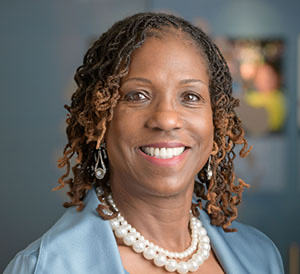When the coronavirus pandemic prompted Ohio schools to close in March, district administrators, teachers, students and their families scrambled to quickly adapt to online learning. In northeastern Ohio, Akron Public Schools, the state’s fifth-largest district, gave its families much needed extra help.
Under the leadership of Carla L. Chapman, District Director of Community Relations, Diversity, Equity and Inclusion, a team created the Connectors program. Through the program, 254 trained, non-instructional staff members called Akron students to determine their needs, logging more than 10,000 interactions during 52 days of remote learning. The program helped many of the approximately 22,000 Akron students with such things as using unfamiliar technology at home to accessing food, health care and child care. And the program is underway again for the new school year. For her efforts, Chapman has been named recipient of OSLN’s 2020 Ohio STEM Innovator Award, as she has “demonstrated an outstanding contribution to the support of STEM education and outreach within her region.”
Chapman, an Akron Public Schools employee since 1994, gave us a look at the Connectors program:
Q: Tell us about the Akron Public Schools district.
 A: Akron Public Schools (APS) serves our community of 198,000 with 47 schools, or community learning centers, as we now call them. We are a diverse, urban system serving a city covering 62 square miles.
A: Akron Public Schools (APS) serves our community of 198,000 with 47 schools, or community learning centers, as we now call them. We are a diverse, urban system serving a city covering 62 square miles.
Q: What prompted the creation of the Connectors program?
A: The program was directed from the superintendent’s and assistant superintendent’s offices, based on the understanding of our families and how our district might need to support them during this difficult time. The intent is to proactively make “connections” with families to head off any issues that might prevent engagement with online learning.
Q: Along with yourself, who else was involved with the program? How was the program administered?
A: The team included district employees and a member of the local United Way staff who coordinates family wrap-around supports. We also leveraged the United Way’s 211.org referral system to train our connectors and utilized this system of referral throughout the program.
The program was administered with direction from the team to the building principals who chose their building connectors and managed data collection.
Q: What tasks did the Connectors program tackle?
A: Connectors addressed any issue that impedes learning – academic, internet connectivity, basic needs and social-emotional support s – by using a system of referral that linked families to persons and/or agencies best equipped to handle the issue.
Our district managed a help desk for academic supports (separate from Connectors), an internet elite team (separate from Connectors). Both were included in the referral network created for Connectors to use.
Community agencies and the United Way 211.org program rounded out the resources available to Connectors to make referrals.
Q: What were some of your biggest challenges, and how did you handle them?
A: The nature and complexity of issues that we encountered was not a surprise but a reminder that families often have stressors that directly impact student learning. Connectors were trained to listen and respond accordingly, with empathy and relationships at the center.
Q: How long did the program run, and how did you refine it over time?
A: Connectors 1.0 ran from March through the end of the school year in June. Connectors 2.0 is up and running, with tweaks made to management and/or additional services including an After Hours Support Center, receiving calls during the 4-7 p.m. hours so no family gets lost.
Connectors 2.0 has moved to management under the school counselors’ office. The After Hours Support Center team is being coordinated by a group of learning specialists, district after-school managers. The same referral resources are available during the After Hours Support Center as are available to Connectors during the school day. Also, each school has identified a lead Connector to support the triaging of calls and referrals at the building level versus having all supports being managed for each building at the district level.
Q: What kind of feedback did you receive?
A: Connectors reported positive feedback from families. They also shared some ideas for improvement in a year-end survey.
Q: What advice would you give other districts that might want to start a similar program for their students and families?
A: Start with a good team experienced in wrap-around supports and knowledge of families and community resources, and work within a school setting.